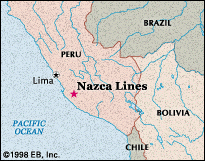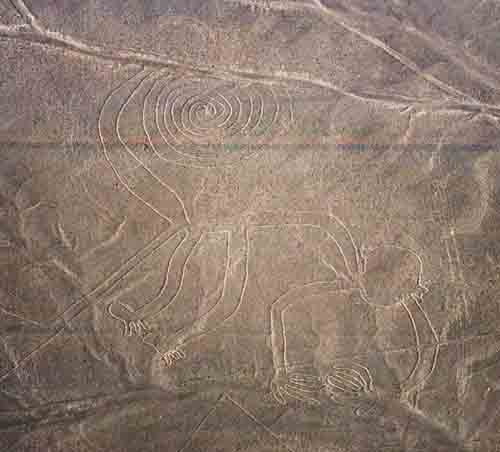The riddle of the Nazca lines has baffled scholars for some time now. Taking a close-up look at the Nazca lines, or better still looking from a distance, it seems inconceivable that this could have been the work of men. Could a primitive people conceive, let alone build such a complex arrangement of drawings on the earth's surface or geoglyphs as they are more correctly known as. They are supposedly the work of the Nazca people who thrived in this southern area of Peru from 200 BC to 600 AD. They consist of large depictions of various animals and plants, geometrical shapes and straight lines. All are apparently scatterd at random over an area of about 200 square miles. The largest figure - the Pelican - is about 280 m long! And most the figures are drawn with a continuous uninterrupted line.
Southern Peru

|
Beginning around 200 BC the Nazca moulded a culture in what is now southern Peru. In this nearly rainless (twenty minutes per year) coastal plain they constructed aqueducts to maximize the use of groundwater and carry this groundwater into reservoirs and irrigation canals. So we know the Nazca people were a competent, skillful and resourceful people. But this type of undertaking had a practical purpose in their very survival. So why such an obsession in terms of time and effort on something they couldn't even visualise. Is it that the lines had a sacred purpose, an offering to the Gods, a place to come and worship, a pilgramige site.
But when were they actually drawn? Linking them to the time of the Nazca people is mainly based on the discovery of some Nazca pottery found embedded in the lines. But this is not clear evidence that they were drawn at this time as the pottery could have become embedded in the lines a long time after their creation. Also, patterns evident in the geoglyphs are repeated in other examples of Nazca art such as the brightly coloured pottery and textiles. Birds, lizards, whales and other animals are common themes. So although much of the Nazca people's artefacts did use similar styles to the geometric shapes we see in the Nazca lines does this mean that the lines and the artefacts originated along side each other or could the lines be the inspiration for the pottery (If so, it would mean the pottery makers could visualise the lines). So while we can date the pottery we cannot be really certain about the lines age. It must also be noted that there is no evidence of pre-Nazca cultures living in this area so perhaps after all it was the work of the Nazca people. After all, graves and ruins of their settlements have been found near the lines.
Nazca Spider

|
The lines themselves were created by removing the dark red surface soil and stones, which resulted in exposing the lighter coloured subsoil. This resulting colour contrast creates the 'lines'. They were created over possibly hundreds of years, or at least over several generations. But because of their sheer size, most of the geoglyphs cannot be recognised at ground level. Only from an altitude of several hundred feet do the various features and shapes become apparent. At ground level they appear as grazes in the surface no more that a few inches deep. And there are no elevation points nearby to allow them to be viewed.
In 1977, Jim Woodman suggested that the Nazca people constructed hot air ballons to use as a vantage point to view the lines. He and his collegues actually went as far as successfully building a hot air ballon using only materials that would have been available to the Nazca people in those days. However, it must also be said that they had the advantage of being familiar with the concept of a hot air ballon in 1977 - unlike the Nazcas perhaps 2000 years earlier. Some people have said there is a hint of hot air to Jim Woodman's theory.
Because the local climate is so dry and there is very little erosion, nearly all of the geoglyphs remain intact since they were first drawn. Once a feature is drawn in this barren and inhospitable landscape it tends to last forever. The line makers choose their location well. However, perhaps they didnt anticipate their descendents contribution to climate change in the late 20th / early 21st century and the threat this may bring to the climate of this area. The lines days could well be numbered.
Given enough time and enough human resources, accomplishing the job of removing thousands of tons of material is no mystery. But to create geometric shapes and animal and plant depictions in such accurate large proportions would have required good levels of skill and surveying knowledge and equipment. Were these available during the lifetime of the Nazca people or maybe even for the culture preceding the Nazca culture on these plains?
Nazca Monkey

|
Archaeologists are still puzzled over the purpose of Nazca lines. Were they astronomical alignments? Or were they built for religious reasons as is the usual for large monuments of ancient times. Did they mark ritual pathways (since the lines are wide enough to walk in and almost all the geoglyphys are made up of one continuous line) and connect sacred sites? Experts still disagree!
So will we ever know who created this art gallery in the desert. And why? The 'Why' has certainly defied explanation to-date. What possible purpose could they serve. And who could actually view them until the early 20th century when man could view them with the advantage of flight. People around the area today still believe that they were not the work of men, but of Viracocha - the 'Creator God' of the pre-Inca inhabitants of Peru. (What exactly do they mean by that?) We still lack some vital information to solve the mystery.
Erich von Däniken proposed, in his 1968 book 'Chariots of the Gods', that the lines were built by aliens as a landing field for their spaceships! While this controversial theory certainly generated much interest in the Nazca lines (which in itself was very beneficial) it has since been shown to be very unlikely that this could ever have been their function.
Theories as to why they were made include the following;
Each figure is constructed from a single line, so they could be walked during ceremonies.
Astronomical observatory: Many of the lines point to constellations and can be tied to solstices and equinoxes
The desert-dwelling Nascans were obsessed about water, and the lines may somehow map underground sources.
UFO landing strips: Erich Von Daniken popularized this theory. See the Nazca Astronaut below.
Nazca Astronaut?

|
The Nazca did not erect any masonry monuments? This was unusual for a culture so immersed in art! Why the preoccuptation with whales? Was it linked to fishing from their distant past?
What did the Nazca people do with the lines once created - how did they 'use' them
Why did the Nazca, and likewise some other cultures, not invent writing?
Why did they settle in such an arid and barren region instead of moving to greener pastures?
Similarities in their pottery and geoglyphs: Could the pottery be based on the geoglyphs - why assume that both were created at the same time?

